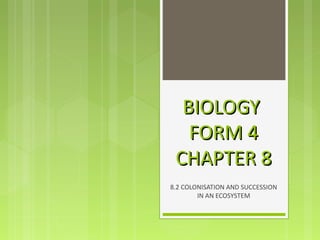Biology Form 4: Chapter 8.2 Colonisation and Succession in an Ecosystem
- 1. BIOLOGYBIOLOGY FORM 4FORM 4 CHAPTER 8CHAPTER 8 8.2 COLONISATION AND SUCCESSION IN AN ECOSYSTEM
- 2. ECOSYSTEM A community of living organisms interacting with each other and with the non-living environment.
- 3.  HABITAT  SPECIES  POPULATION  The natural environment in which an organism lives and get their food, shelter, living space, and breeding sites.  Consists of a group of organisms that look alike and have similar characteristics, share the same ecological niche and are capable of interbreeding and producing fertile offspring.  Consists of a group of organisms of the same species living in the same habitat at the same time.
- 4.  COMMUNITY  NICHE  A naturally occurring collection of plant and animal species living within a defined area in and ecosystem  The function of an organism or the role plays in an ecosystem.
- 7. COLONISATION The process whereby living organisms move into this newly formed area which is completely devoid of life.
- 8. SUCCESSION The gradual process where one community changes its environment so that it is replaced by another community.
- 9. Colonisation & Succession in Mangrove Swamps (Paya Bakau)  Mangrove swamps found in tropical regions where fresh water meets salt water.  They have a bad environment for normal plants.  soft muddy soil and strong coastal wind  high concentration of salt  very low levels of oxygen  exposed to high intensity of sunlight
- 15. Profile of Succession in a Mangrove Swamp The colonisation and succession occur. The condition becomes more suitable for the successors which are the dominant species at that time.
- 16. Distribution of Mangrove Trees in the Banks of Rivermouth
- 17. Processes of Colonisation and Succession in a Pond
- 19. 1. Pioneer stage ï‚› When pioneer plants die and decompose, the organic matter settle to the bottom of the pond and make the pond shallower. ï‚› This produce suitable conditions for aquatic floating plants. 2. Succession by aquatic floating plants ï‚› Floating plants cover the surface of the pond and prevent light from entering the pond. ï‚› Pioneer plants cannot perform photosynthesis and die. These dead plants will sink to the bottom and increase the organic matter layer of the bottom.
- 20. 3. Succession by amphibious plants ï‚›Dead aquatic floating plants and eroded soil from the pond banks will raise the pond floor and make the pond too shallow for aquatic plants to float. ï‚›The aquatic plants are succeeded by amphibious plants. 4. Succession by herbaceous plants ï‚›The continued deposition of organic matter enables grass to gradually replace amphibious plants.
- 21. 5. Succession by woody plants ï‚›The death of amphibious plants caused continued deposition of organic matter and evaporation of pond water will make the pond very shallow and eventually dry it up. ï‚›Finally land plants and other woody plants will replace the amphibious plants and form a jungle. 6. Climax community ï‚›The succession will stop when a level of balance is achieved.





















